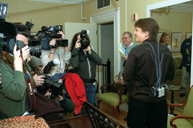Plugged into Mozart
CIRMMT research looks to unlock the mysteries of music

Keith Lockhart shows off his body sensor wiring in a pre-concert photo op.
MIRO VINTONIV
When Keith Lockhart, the boyishly charismatic conductor of the famous Boston Pops, strode to the podium on April 8 as part of the Boston Symphony Orchestra's family concert series, he was wired: Wired for sound.
As part of a McGill study to measure the effects of music on the human brain, Lockhart was fitted with a skintight vest equipped with sensors that monitored his every heartbeat and muscle twitch. Five members of the orchestra were similarly decked out, while some 50 volunteers — both adults and children — in the audience were hooked to simple sensors.
Although the high-tech gear was recording a variety of physical responses, researchers hope that once the collected data is analyzed, they will have a window on what goes on inside the heads of musicians and audience members during a concert. "The ability to study a performing musician's brain is somewhat limited because you have to lie perfectly still during an MRI," explains Daniel Levitin, a cognitive neuroscientist at the department of psychology. "But the brain controls your galvanic skin response — your pulse, the amount you sweat, the things that have been shown to be correlated with different emotional states. It's like a mechanic who can tell you what is wrong with your car's engine just by listening to it."
The study should shed light on several questions, including how successfully a conductor transmits the emotions he feels during a performance to the musicians he is leading. Similarly, does listening to a piece of music elicit feelings within audience members that correspond to those felt by performers? Is the experience diminished or heightened as it moves from baton to bassoon to balcony to back row?
A second part of the study, in which a test group in Montreal will be monitored as they watch a recording of the same concert, will rate similarities and differences in emotional responses among listeners of live versus recorded concerts.
Levitin and Stephen McAdams, director of McGill's Centre for Interdisciplinary Research in Music Media and Technology, hypothesize that whatever "emotional fingerprint" was registered by Lockhart during the climax of the Overture to the Marriage of Figaro was echoed a split second later by musicians and again by listeners. "Musicians often wonder if the audience shares what they are feeling inside when they are playing," says Levitin, himself a saxophone player. "This might help answer that question."
Aside from a pesky sensor that popped off Lockhart's wrist during one Mozart piece, the trial went off without a hitch. Pre-event interest was so high that by concert time the gallery included a gaggle of media types, including network camera crews and a reporter from Associated Press. Ever the showman, Lockhart turned to address the crowd, saying this kind of work is important because "it will allow us to get a better understanding of the most important musical instrument of all; the human brain."

